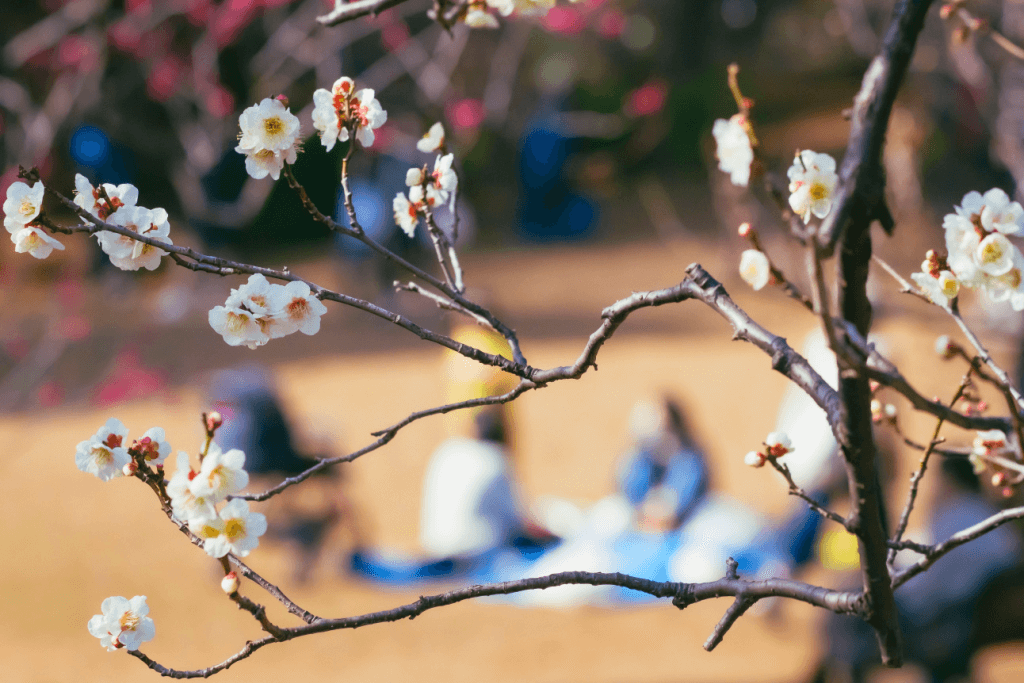Plum Blossoms: The Best Early Spring Flower

Anne Poesnecker
Posted on February 27, 2023
Share:

Plum blossoms in Japan are stunning! If you plan a late April sakura vacation to Japan, consider the mid-February Ume Matsuri, the plum blossom festival. This Japanese event lets you avoid crowds and exorbitant prices. Hanami, the traditional flower viewing event, includes plum and cherry blossoms.
Ume blooms are white, pink, or deep red and are more fragrant than cherry blossoms. Plum blossoms bloom before cherry blossoms, signaling spring. The Ume Matsuri immerses visitors in Japanese culture with tea rituals and music performances.
Ume groves and plum blossom-adorned parks and temples can also be peaceful. Plum blossoms are less recognized than cherry blossoms, but they offer a different and magnificent experience worth considering when visiting Japan.
What are Plum Blossoms?
Surprisingly, hanami is a relatively modern phenomenon. During the Heian period (794-1185 CE), the cherry tree became accessible to everyday people. Before this period, the coveted tree and its light pink flowers were a luxury. The nobility purposefully kept them exclusive; only the highest society members could access them.

That’s not to say the celebration of the blooming of seasonal flowers in Japan didn’t extend outside of the aristocratic class before the Heian period or the spread of the cherry tree. The blooming of the ume (plum blossom) tree signified the beginning of spring. China introduced these plum trees during the Nara period (710-784 CE). Afterward, their dark pink petals inspired ume matsuri (plum blossom festivals).

Not only do periods of history separate the celebrations of the two fruit-bearing trees, but also the time their flowers appear. The cherry tree blooms in late April, producing pastel pink flowers extending in clusters off the tree’s main branches.

The plum tree’s dark pink flowers form in independent sections directly on the branch and begin to appear as early as February. For that reason, plum blossoms represent the onset of spring and, more poetically, hope and perseverance amidst hardship.
Symbolism
This symbolism is treated as something akin to reverential, playing an integral role in early Japanese poetry and art. Before the adaption of the Gregorian calendar, the term ume represents the early spring period across traditional art forms such as haiku and poetry.

Of course, the significance of the plum blossom isn’t only a poetic expression. This imagery can also be found in traditional Japanese paintings, as a popular motif on kimonos, and even represents a whole suit in the 19th-century Japanese card game Hanafuda.
Want some fantastic snacks to go with your lovely hanami picnic? Check out Sakuraco! Sakuraco delivers traditional Japanese snacks, teas, sweets, and snacks from local Japanese makers directly to your door so you can enjoy the latest treats from Japan!

Plum Blossom Viewing in Contemporary Japan
So, now you know the history of ume matsuri in Japan. You even know when to visit to see the Japanese plum blossoms in full bloom. The question now is where in Japan should you go, and what will be waiting for you when you get there? No need to worry. You’re in no way facing a shortage of options.

Tokyo’s go-to urban center for Ume Matsuri is the Japanese Garden in Koishikawa Korakuen. Less than 20 minutes from Tokyo’s imperial palace by train, this park contains around 150 ume trees. These gardens date back to the country’s Edo Period (1603-1868 C.E.) and have long been an oasis for plum blossom viewing amongst the urban bustle.
For those both willing to travel and wanting to view Japan through the eyes of its history, Japan’s Ibaraki Prefecture is home to the gardens of Kairakuen. Located only a 2-hour train ride from Tokyo Station, this garden hosts over 3000 ume trees and holds a title as being one of the Three Great Gardens of Japan.

For those who want to delve into adventure, Fukuoka Prefecture houses the Dazaifu Tenmangu Shrine—built in 905 C.E.; the grounds of this Shinto shrine host over 6000 Ume Trees in 167 different varieties. This off-the-beaten-path option is the ultimate viewing experience for all things ume matsuri and Japanese historical tradition.
Those who have thought of visiting Japan have heard of cherry blossoms and the traditional affairs surrounding them. However, by delving into the lesser-known celebrations of the ume blossoms, you’ve uncovered an earlier beautiful season of blooming flowers.

Discover authentic flavors with Sakuraco
Get Sakuraco 

Discover authentic flavors with Sakuraco
Get Sakuraco 
Related Articles

Steam Train in Shizuoka: Riding the Oigawa Railway
For travelers who love history, beautiful views, and cozy retro vibes, this steam train is one of Shizuoka’s most charming treasures, with some of the best views. If you want to know more about this train, keep reading below!

Nara Japan: The Amazing Legend of the Sacred Dragon
In Japanese culture, dragons are spiritual beings that represent strength, prosperity, and a harmonious balance with the natural forces. Nara, Japan, has a unique story associated with sacred ponds and revered shrines throughout the region.

Nambu Tekki: Morioka’s Amazing Iron Craft
In the historic city of Morioka, Iwate Prefecture, a craft with over 400 years of history continues to captivate with its rustic beauty and practical charm. Nambu tekki, or Nambu cast iron, refers to traditional ironware, such as teapots, kettles, and decorative pieces, that embody the spirit of Tohoku craftsmanship.

Ebisu: The Cheerful Guardian of Luck and Prosperity
Religion in Japan involves a dizzying array of spirits and beings. These gods are inspired by ancient tales and used to symbolize nature’s bounty. However, they also profoundly impact daily life and are often sought out for help in challenging times


